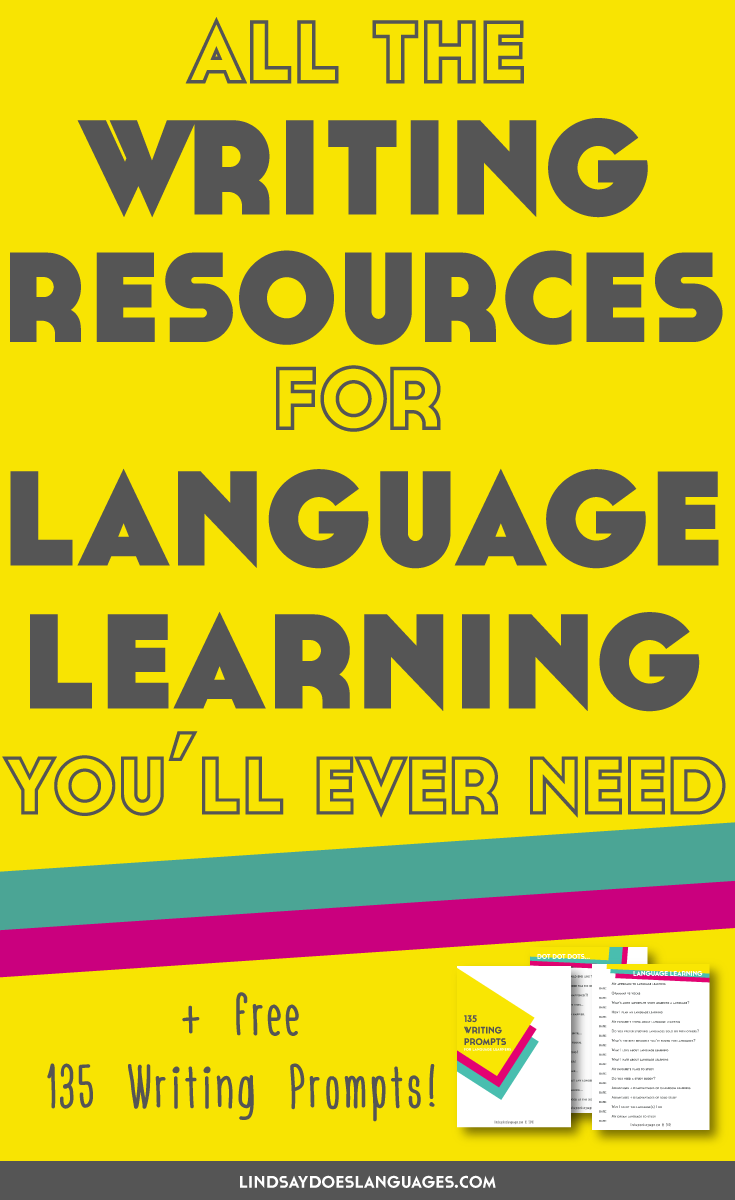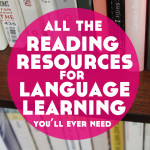Of the four key skills of language – reading, writing, speaking, and listening – writing is often the most likely to be ignored. The least useful skill, the one that won’t help, the one we can ignore. But this isn’t necessarily true. Here are all the writing resources for language learning you’ll ever need.

The Role of Writing In Language Learning
Before we begin, let’s clear something up.
Maybe you’re thinking that writing isn’t that important and you don’t really need to bother with it for the language you’re learning.
Even if that is the case and you’re learning a language purely for speaking and listening, writing can still play an important role in the learning process.
To learn how, watch the video below…
There are many different ways you could divide writing resources: spelling, character/alphabet practice, creative writing, purposeful writing…the list goes on.
However, for this list, we’re going to keep it simple and focus on two particular types of writing that are present in modern life: digital writing and physical writing.
Both play an important role in developing your foreign language writing skills.
It’s likely you’ll be making initial notes in class on paper, yet you may type up your homework on a computer.
If you’re outside of a classroom setting, then perhaps you’re sending chat messages to new found language exchange friends, but also needing to fill out formal job application forms by hand.
Digital Writing
italki Notebook
If you already use italki for speaking practice with lessons and language exchange, bring in use of the Notebook feature. This will extend your use of the site to flex your writing muscles as well.
The easiest way to do this is to start by writing something after each italki session. It could be writing sentences based on the language you’ve learnt during the lesson. Perhaps it could be writing about a topic you discussed in the lesson. Or it could be a summary of the lesson itself…whatever works for you!
Social Media
I’m a huge fan of using social media for language learning. I even host the Instagram Language Challenge (#IGLC) for free every single month to help you learn a little language each day on Instagram.
When it comes to writing, social media captions are a great place to practise. You write something super short such as a limited character Tweet.
However, if you’re needing longer writing practice, you can do that too. Facebook Groups designed specifically for that purpose or Instagram captions are great for this.
Related: Why Social Media is the Best Free Language Learning Tool
Different keyboards
On social media or using any of the apps mentioned in this list on your phone or tablet? You’ll want to make sure that you’ve got the right keyboards installed.
If you’re lucky, your language keyboard will even come with auto-correct. This will help you master those pesky spellings that just don’t make sense (why is there an accent on that letter?!)
Not only that but for some languages, learning how to type on a mobile keyboard in that language is quite different to English. This makes it a process worth investing some time in.
For iOS, check here to see how to install different keyboards if you haven’t already.
And if you’re on Android, Multiling O Keyboard looks like a good starting point.
CleverBot
Simply open up the web page and start chatting in any language for an AI generated response. Although it’s far from perfect, CleverBot is a handy tool to try out basic chat with a bot.
However, it is worth noting that not everything it says will be grammatically correct!
This is a good thing though because it encourages you to notice errors and think about how you would respond correctly instead.
HelloTalk
HelloTalk is one of my favourite language learning apps.
The format is simple: let HelloTalk know the basics about you and it’ll find you users from across the globe to text and even video chat with.
I find it particularly useful for writing in a casual setting, and it’s a great tool to combine language skills practice in one place.
Related: HelloTalk Review.
Tandem
Tandem does a similar thing to HelloTalk. Try them both and see which one suits you best.
Related: Practising 8 languages in 30 minutes with Tandem
Lang8
One of the classic writing resources for language learning, Lang8 is a great place for regular writing practice of varying lengths.
There’s a community element to it, so when you post your writing, you’re inviting others to share corrections on what you’ve written, which is ideal for self-studiers!
Personally, I love to use it to document my progress and see how my simple sentences advance to more complex writing.
HiNative
Brought to you by the same team behind Lang8, HiNative is an app that allows you to ask questions to native speakers.
Why does that verb conjugate that way? What’s the different between those two similar words? How the heck do you pronounce that word?!
HiNative is the place to get answers to help you improve your writing, and language skills in general.
My Language Exchange
There are more language exchange sites online than you can shake a stick at!
I tend to keep things simple and stick with italki, HelloTalk or Tandem, but if I haven’t found what I’m looking for there, My Language Exchange seems to be the next best place to start looking.
Use the site to find partners to set up a language exchange with. Of course, this can be spoken, but you could just as easily use the site to set up a regular written exchange via email for example.
TypeIt
If you’re typing on a computer, it isn’t always easy to remember which keycodes you need to enter to get which accented letter, especially when there’s multiple languages involved.
TypeIt is a helpful website with accent lists for various languages and a simple to use copy and paste textbox to write what you need and get it where you need to write it easily.
Typing Symbol Codes
Alternatively, if you’re typing in multiple languages in one document, this page has all accented letters on one page to copy and paste as and when you need.
Handily, it also shows you the keycodes underneath each letter to help you learn how to access them easier in future.
RhymeBrain
If you’re reached the stage where you’re getting into creative writing in the language you’re learning, this rhyming dictionary in English, German, Spanish, French, Hindi, Italian, Dutch, and Russian.
It’s better for some languages than others, and doesn’t always give a perfect rhyme but it makes for an interesting look at language as you begin to advance in it.
Text Inspector
Founded by the late great Professor Stephen Bax (definitely check out his work on the Voynich Manuscript), Text Inspector is an essential tool for advanced learners of English.
Put your writing to the test by analysing it for readability and lexis among other things.
Physical Writing
Lindsay Does Languages Notebooks
If you’re all about good looking language notes, then the Lindsay Does Languages Notebooks are a must. I designed them with language obsessionad@s like myself in mind – that’s you, right?
Pick between three designs; hardbound or spiral; and plain, grid, or lined paper on the inside to cover all your preferred language writing practice needs.
Specialist Notebooks for Certain Language
If you’re learning a language with a different writing system to English, you’ll also need some time to get used to the letters and words as you start to learn the language.
Using a notebook designed specifically for learners of that language can be a great idea here. Try this one for Japanese or this one for Chinese.
The Right Pens
Most of the time, a scrappy old Biro will do the job just fine.
However,if you want to take some time to really enjoy the process, or perhaps are using a study technique such as the Goldlist Method, then investing in a nice pen can be a real gamechanger. Surprisingly, it can really affect how enjoyable writing in the language you’re learning can be.
These calligraphy brush pens are ideal for languages with different scripts.
But if you do prefer a ballpoint or fountain pen, then Parker has you covered.
PenPalWorld
Take your written language exchange offline and old school with a handwirtten pen pal on PenPalWorld. Work on your writing with a penpal from across the globe and learn about other people and places in the process too!
Wreck This Journal
If you’re struggling to get creative with the language you’re learning, let Wreck This Journal do the hard work for you.
Each page comes with a new prompt to draw, write and get creative. And the good news is that it’s available in multiple languages: Spanish, French, German, Dutch, Italian, Portuguese.







